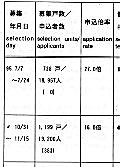 back
back  index
index  next
next
2. Disaster Restoration Public Housing and the Group Transfer System

|
| Types of Disaster Restoration Public Housing etc. |

|
| Table-5 Condition of application and result of selection of disaster restoration public housing (in Kobe City) |
 back
back  index
index  next
next